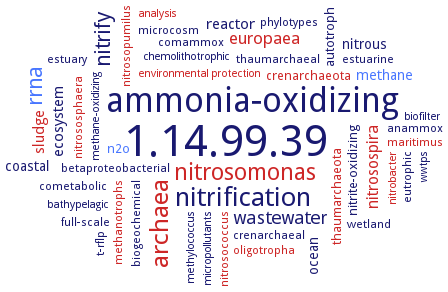1.14.99.39: ammonia monooxygenase
This is an abbreviated version!
For detailed information about ammonia monooxygenase, go to the full flat file.

Word Map on EC 1.14.99.39 
-
1.14.99.39
-
ammonia-oxidizing
-
nitrification
-
archaea
-
nitrosomonas
-
nitrify
-
rrna
-
wastewater
-
europaea
-
nitrosospira
-
ecosystem
-
reactor
-
sludge
-
methane
-
ocean
-
nitrous
-
coastal
-
thaumarchaeota
-
crenarchaeota
-
nitrite-oxidizing
-
autotroph
-
n2o
-
wetland
-
phylotypes
-
comammox
-
full-scale
-
eutrophic
-
oligotropha
-
crenarchaeal
-
microcosm
-
thaumarchaeal
-
t-rflp
-
estuary
-
betaproteobacterial
-
estuarine
-
maritimus
-
anammox
-
nitrosococcus
-
nitrososphaera
-
cometabolic
-
methanotrophs
-
biogeochemical
-
nitrosopumilus
-
analysis
-
biofilter
-
chemolithotrophic
-
environmental protection
-
wwtps
-
micropollutants
-
nitrobacter
-
methane-oxidizing
-
methylococcus
-
bathypelagic
- 1.14.99.39
-
ammonia-oxidizing
-
nitrification
- archaea
- nitrosomonas
-
nitrify
- rrna
-
wastewater
- europaea
- nitrosospira
-
ecosystem
-
reactor
- sludge
- methane
-
ocean
-
nitrous
-
coastal
- thaumarchaeota
- crenarchaeota
-
nitrite-oxidizing
-
autotroph
- n2o
-
wetland
-
phylotypes
-
comammox
-
full-scale
-
eutrophic
- oligotropha
-
crenarchaeal
-
microcosm
-
thaumarchaeal
-
t-rflp
-
estuary
-
betaproteobacterial
-
estuarine
- maritimus
-
anammox
- nitrosococcus
- nitrososphaera
-
cometabolic
- methanotrophs
-
biogeochemical
- nitrosopumilus
- analysis
-
biofilter
-
chemolithotrophic
- environmental protection
-
wwtps
-
micropollutants
- nitrobacter
-
methane-oxidizing
-
methylococcus
-
bathypelagic
Reaction
Synonyms
ammonia monooxygenase, AMO, AMO-Ne, amoA, AmoB, AmoC3, copper-containing membrane-bound monooxygenase, CuMMO, low-temperature ammonia monooxygenase, Ny_amoB
ECTree
Advanced search results
Inhibitors
Inhibitors on EC 1.14.99.39 - ammonia monooxygenase
Please wait a moment until all data is loaded. This message will disappear when all data is loaded.
1,2-dimethylcyclopropane
-
22 mM, 93% inhibition, mechanism-based inactivator, ammonia enhances the rate of inactivation
1,3-phenylenediamine
-
0.05 mM, 93% inhibition, mechanism-based inactivator, ammonia enhances the rate of inactivation
1,7-octadiyne
17OD, complete inhibition, inactivation of NH4+-dependent O2 uptake by Nitrosomonas europaea in a time- and concentration-dependent manner. The effects of 17OD are specific for ammonia-oxidizing activity (17OD has no inhibitory effect on NH2OH-dependent O2 uptake), and de novo protein synthesis is required to reestablish this activity in cells exposed to 17OD. NH4Cl does not protect against inactivation of ammonia-oxidizing activity by 17OD under the conditions tested. 17OD is an irreversible inactivator of AMO
1-hexyne
-
mechanism-based inactivator, ammonia enhances the rate of inactivation
3-hexyne
-
mechanism-based inactivator, ammonia enhances the rate of inactivation
allylsulfide
-
specific, mechanism-based inactivator, anaerobic conditions or the presence of allylthiourea protect the enzyme from inactivation, ammonia increases the rate of inactivation
chloramphenicol
rate of NO2- production by 1,7-octadiyne-untreated cells is about 30% lower in the presence of chloramphenicol
cyclopropyl bromide
-
0.007 mM, 97% inhibition, mechanism-based inactivator, ammonia slows the rate of inactivation
Dimethylsulfide
-
weak inhibitors of ammonia oxidation. Depletion of dimethylsulfide requires O2 and is prevented with either acetylene or allylthiourea
p-anisidine
-
0.05 mM, 98% inhibition, mechanism-based inactivator, ammonia enhances the rate of inactivation
rifampicin
rate of NO2- production by 1,7-octadiyne-untreated cells is about 15% lower in the presence of rifampin
Acetylene
-
mechanism-based inactivator, ammonia slows the rate of inactivation
Acetylene
-
mechanism-based inhibitor, specifically interacts with catalytically active ammonia monooxygenase
Acetylene
-
two populations of AMO in cell extracts. The low, copper-independent (residual) AMO activity is completely inactivated by acetylene in the absence of exogenously added copper. The copper-dependent (activable) AMO activity is protected against acetylene inactivation in the absence of copper. In the presence of copper both populations of AMO are inactivated by acetylene
Acetylene
-
His191 is part of the acetylene-activating site in AMO or at least directly neighbours this site
-
active-site model for ammonia monooxygenase consisting of an NH3-binding site and a second site that binds noncompetitive inhibitors, with oxidation occurring at either site
-
additional information
many alkynes are mechanism-based inactivators of AMO, activity-based protein profiling method for the enzyme using 1,7-octadiyneas a probe. Many organic compounds reversibly inhibit ammonia oxidation through their action as alternative substrates for AMO. These compounds include diverse alkanes, alkenes, aromatics, ethers, and halogenated compounds. The simplest organic AMO substrates, such as methane and ethylene, are competitive inhibitors of ammonia oxidation, while other substrates exhibit more complex inhibition patterns. Mechanism-based enzyme inactivation, overview. The free ethynyl group of the inactive enzyme-inactivator adduct is conjugated with either a visualization tag (e.g., Alexa Fluor 647 azide) or an affinity purification tag (e.g., biotin-azide) using a copper-catalyzed azide-alkyne cycloaddition (CuAAC) reaction. The resulting enzyme-probe-tag conjugant can then either be (i) visualized using IR fluorescence in SDS-PAGE or (ii) enriched by affinity chromatography, tryptically digested, and identified by LC-MS/MS
-
additional information
-
many alkynes are mechanism-based inactivators of AMO, activity-based protein profiling method for the enzyme using 1,7-octadiyneas a probe. Many organic compounds reversibly inhibit ammonia oxidation through their action as alternative substrates for AMO. These compounds include diverse alkanes, alkenes, aromatics, ethers, and halogenated compounds. The simplest organic AMO substrates, such as methane and ethylene, are competitive inhibitors of ammonia oxidation, while other substrates exhibit more complex inhibition patterns. Mechanism-based enzyme inactivation, overview. The free ethynyl group of the inactive enzyme-inactivator adduct is conjugated with either a visualization tag (e.g., Alexa Fluor 647 azide) or an affinity purification tag (e.g., biotin-azide) using a copper-catalyzed azide-alkyne cycloaddition (CuAAC) reaction. The resulting enzyme-probe-tag conjugant can then either be (i) visualized using IR fluorescence in SDS-PAGE or (ii) enriched by affinity chromatography, tryptically digested, and identified by LC-MS/MS
-
additional information
-
ordinary laboratory lighting inhibits ammonia monooxygenase over a period of 1 h. Acetylene is not an inhibitor at 1 mM
-


 results (
results ( results (
results ( top
top






